coordinate system
The so-called coordinate system includes two aspects: one is the size of the ellipsoid used in calculating of the measurement results on the geoid to the surface of the ellipsoid; the other is that the relative positions of the ellipsoid and the geoid are different, and the results calculated on the geographic coordinates of the same point will have different values. Therefore, a certain size ellipsoid is selected and its position with the geoid is determined, so a coordinate system is determined (Fig. 4-3)。
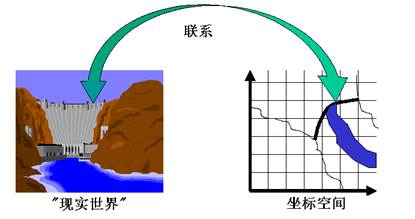
The relationship between the real world and coordinate space
Geographic coordinates
In addition to revolving around the sun, the earth revolves around its own axis. The axis of rotation coincides with the short axis of the ellipsoid and intersects with the ground at two points, namely, the two poles of the earth, the North Pole and the South Pole. The plane perpendicular to the earth’s axis and passing through the earth’s center is called the equatorial plane, and the large circle (intersection line) intersecting the equatorial plane with the earth’s surface is called the equator. The circles parallel to the equator are called the parallels. Obviously, the equator is the largest latitude circle。
The plane perpendicular to the equatorial plane through the earth’s axis is called Meridian, and all meridians are equal in length to each other. (Fig. 4-4)
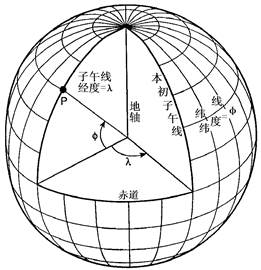
Longitudes and Latitudes of the Earth
Latitude
Let there be a point P (Fig. 4-4) on the ellipsoid surface, and make the vertical line of the ellipsoid through the point P, which is called the normal line passing through the point P. The angle between the normal line and the equatorial plane, called the geographic latitude of point P (referred to as latitude), is usually written in letters.φRepresentation. Latitude starts from the equator, and is 0 on the equator. The farther the latitude is from the equator, the greater the latitude is, and the latitude to the pole is 90 degrees. To the north of the equator is called the northern latitude, and to the south is called the southern latitude。
Longitude
The dihedral angle between the meridian plane passing through point P and the meridian plane passing through Greenwich Observatory is called the geographic longitude of point P (longitude for short), which is usually expressed by the letter lambda. According to international regulations, the meridian of Greenwich Observatory is the primary meridian (or the first meridian) as the starting point of longitude calculation. The longitude of this line is 0 degrees, 0-180 degrees to the East is called the East meridian, and 0-180 degrees to the west is called the West meridian。
Determination of points on the ground
The position of any point on the ground is usually determined by longitude and latitude. Longitudinal and latitudinal lines are two sets of orthogonal (intersection 90 degree) curves on the surface of the earth. The coordinates formed by these two sets of orthogonal curves are called geographic coordinate systems. The difference of longitude between two points on the surface is called longitude difference, and the difference of latitude between two points is called latitude difference. For example, Beijing’s position on the earth can be determined by north latitude 39 56’ and the East longitude 116 24’。
Coordinate system on the plane
Geographic coordinates are a kind of spherical coordinates. Since the surface of the earth is an unfoldable surface, that is to say, the points on the surface can not be expressed directly on the plane, it is necessary to use the method of map projection to establish the functional relationship between the surface of the earth and the points on the plane so that any point on the surface of the earth can be coordinated by geographical coordinates.(φ、λ) A fixed point must have a corresponding point on the plane. The position of any point on the plane can be expressed in polar coordinates or rectangular coordinates。
Establishment of plane rectangular coordinate system
Choose a point on the plane.O For the origin of rectangular coordinates, go through that pointO as two axes perpendicular to each otherX’OX "And” *Y’OY* toestablish a plane rectangular coordinate system as shown in Fig. 5。
In the Cartesian coordinates system, the ruleOX, OY direction is positive.OX, OY direction is negative, so a known point in the coordinate systemP , It can be located by this point pair.OX“And” *OY* The vertical length of the axis is uniquely determined, i.e.x=AP “y=BP It is usually recorded asP (x, y)。
Establishment of Polar Coordinate System
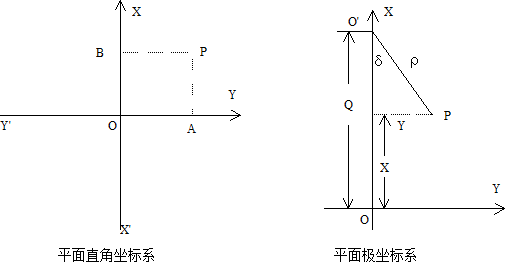
Planar Cartesian System and Polar coordinates System
As shown in Figure 5,set O’ as the origin of polar coordinates.O’O It is the polar axis.P It is a point in the coordinate system.then O’P Called polar distance, with symbolsρ Representation, i.e.ρ=O’P. “ *(OO) P* For the polar angle, use symbolsδ Representation, then∠OO’P=δ. Polar angleδ Starting from the polar axis, it is positive in counterclockwise direction and negative in the clockwise direction。
A certain relationship can be established between polar coordinates and plane rectangular coordinates. Fig. 5 shows that the x-axis of rectangular coordinates coincides with the polar axis, and the distance between the origins of the two-coordinate systemOO’Use *Q* Expressions are as follows:
X=Q–ρcosδ
Y=ρsinδ
Translation and rotation of rectangular coordinate system
Coordinate system translation
As shown in Figure 4-6, the coordinate systemXOY and coordinate systemX ‘O’ Y ‘ The corresponding coordinate axes are parallel to each other and have the same positive direction. Coordinate system X ‘O’ Y ‘ It’s a coordinate system.XOY It is obtained by moving in parallel. Set up P Point in coordinate systemXOY The coordinates in the(x, y) In “ X ‘O’ Y ‘ The median coordinate is(x’, y’)And *(a, b)*isO’ in the coordinate systemXOY Then:
x=x’ +a
y=y’ +b
The former is the coordinate relation of a point before and after the translation of the coordinate system。
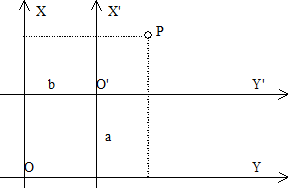
Coordinate system rotation
As shown in Figure 4-7, such as the coordinate systemXOY and coordinate systemX ‘O’ Y ‘ The origin coincides, and the angle between the two coordinate axes isθ The coordinate systemX ‘O’ Y ‘ It’s a coordinate system.XOY O-Centered Counterclockwise Rotationθ It’s got after the corner。
x=x’cosθ+y’sinθ
y=y’cosθ-x’sinθ
The above formula is the relationship of coordinates of a point in the two-rectangular coordinate system after rotating of the θ angle。
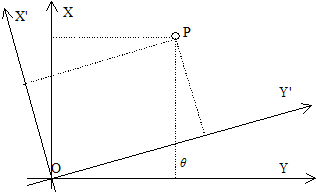
Translation and rotation of coordinate system
As shown in Figure 4-8, the coordinate systemX ‘O’ Y ‘ of the origin is in the coordinate system.XOY The coordinates are a and b.X Axis and X’ The angle between the axes is theta. It can be thought of as a coordinate system.X ‘O’ Y ‘ Originally coincided with the coordinate system XOY, then because O’shifted the distance of a and b, and coordinate system two coordinate axes.O’X’“And” *O’Y’* Relative. OX "And” *OY* Counterclockwise rotationθ It’s got from the angle。
Introducing an auxiliary coordinate system between two coordinate systemsX “O” Y “ To make its two coordinate axisO’X” "And”O’Y”respectively with *OX*, *OY*Parallel。
In “ X “O” Y “ there is a point P in the system whose coordinates are(x, y”) From the translation formula of coordinate system and the rotation formula of coordinate system, we can get that:
x=x”+a
y=y”+b
There are
x”=x’cosθ+y’sinθ
y”=y’cosθ-x’sinθ
Namely
x=x’cosθ+y’sinθ+a
y”=y’cosθ-x’sinθ+b
The upper formula is the relationship between the coordinates of a point in the new and old coordinate systems after translation and rotation of the coordinate system。
